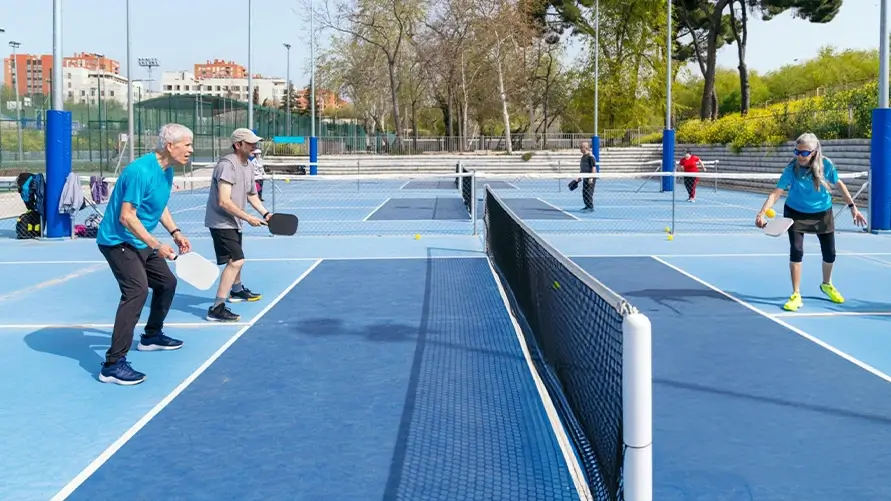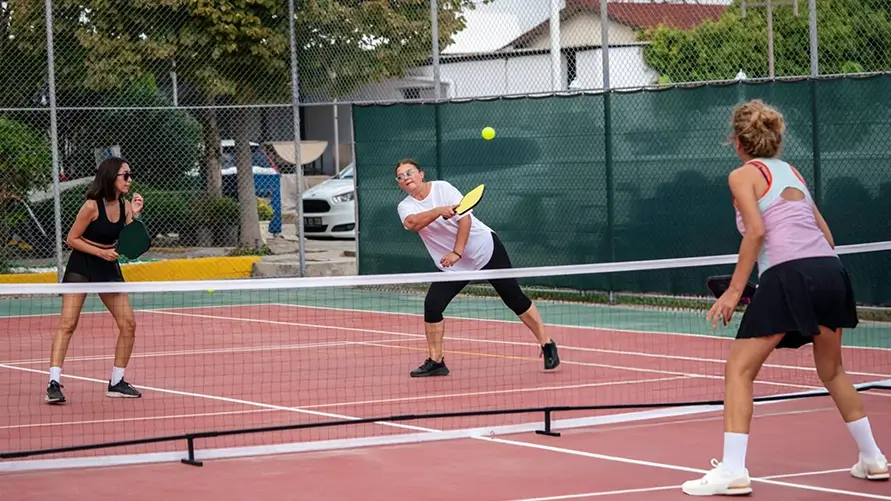Starting a pickleball club isn’t just about taping down some lines and renting space. It’s about building a thriving community that players can’t wait to join, and a business that stays profitable for the long haul.
So, if you have been researching how to start a pickleball club, you’ve probably felt the same anxieties most new owners do:
- Will rent and renovations swallow the budget before players even show up?
- How many courts are enough to break even or make a profit?
- How long before it pays for itself?
These concerns are valid, but so is the opportunity.
According to SFIA, pickleball has grown in the U.S, with over 30 million players in 2024 alone. And there are only about 14,500 courts nationwide. Clearly, there’s a massive gap in supply, and players are eager for well-run clubs that solve their daily frustrations. And to build that good one, you need a proper plan.
So, here’s a realistic, experience-based guide on how to start a pickleball club the right way, with purpose, numbers, and staying power.

Start with research that actually helps
Many clubs fail because owners assume “everyone loves pickleball” means “everyone will pay to play”. But before signing anything, dig into the numbers that help you actually.
Before diving in, spend at least two weeks gathering insights:
- Active demand in your area: Use sites like Places2Play, city recreation data, and Facebook groups to gauge local player numbers.
- Player profiles: Are they league players? Beginners? Seniors? Kids? Since each group has different expectations, from court spacing to lessons, identify the ideal category.
- Competition: Are nearby tennis clubs already offering pickleball? Are public courts empty or packed at peak times?
- Court needs: A good rule of thumb is one court per 12-15 peak players. Too few, and members get frustrated. Too many, and you overpay for underused space.
If your club can fill a real gap, like indoor play in winter, organized leagues, or beginner clinics, you’re starting right on the track.
Crunch the numbers: For the first three years
Knowing how to start a pickleball club also requires knowing what it costs. Here’s a simplified monthly snapshot for a modest 4-6 court facility. If you aim for more courts, increase the estimated range by 1.5-2% for each court.
| Expense | Estimated range |
| Rent & lease | $20,000-$50,000 per year, per court |
| Utilities | $500-$1,200 |
| Insurance | $200-$600 |
| Staff | $2,000-$5,000 |
| Equipment & maintenance | $5000-$10,000 upfront |
| Marketing | $500-$1,500 |
| Management software | $100-$300 |
Most clubs open with about 100-150 paying members in year one. At $40-$75/month, that’s $4,000/month, enough to cover base expenses if you also generate income through drop-ins, tournaments, lessons, and merchandise.
A little reality check here: Expect to operate at a loss first 6-12 months while building your member base. With strong community engagement, many clubs break even by year two.
How to finance your club
When starting a pickleball club, know the sources to finance your business.
Already have $300K or more set aside? Great. If not, there are still practical ways to move forward. Opening a club often requires $100-$300K upfront. For smart start, consider these options:
- SBA small business loans.
- Local economic development grants.
- Partnerships with schools or gyms.
- Private investors in exchange for equity.
A clear business plan improves your chances of approval, and often gets you better terms.
Define a bigger purpose
The most successful clubs go beyond just offering courts. Your city or town might have 109 clubs already. Your 110th pickleball club should offer something better and different from what others already do.
You can create a place where players feel at home. Or create their experience as a part of something meaningful. Your purpose might be:
- A social hub for beginners and casual play.
- A competitive space for advanced players and tournaments.
- A hybrid with leagues, lessons, and social nights.
Write down your mission and let it guide decisions from court layout to booking policies.
Design for players, not just profit
Take a moment to reflect: Are you starting this out of genuine passion for pickleball or purely as a business venture? Are you doing it out of passion for pickleball or just as a business opportunity? You know it yourself.
Saving money upfront often costs more later if players aren’t happy. And that’s when designing a court format with players in mind makes a difference. Whether designed wholeheartedly for players or half-heartedly for the sake of profits only, it’s visible. Most experienced owners say that players care about:
- High ceiling (18-20 feet) so lobs don’t hit fixtures.
- Properly cushioned, non-slip surfaces.
- Bright, even lighting.
- Climate control.
- Safe run-off space between courts.
- Comfortable seating and clean bathrooms.
- Ample parking and clear signage.
These are the details that make players stick around and recommend your club to friends. Also, don’t forget: invest in a reliable booking system before opening day. Nothing frustrates players like double-booked courts or chaotic signups.
Expand your revenue streams
Can memberships alone make up for your court maintenance, rents and bills? No. You need to expand your revenue streams within the same space.
Because membership fees are just one part of the picture. Successful clubs don’t solely rely on memberships. Here is what they earn from:
- Drop-in fees.
- Tournaments and league signups.
- Group and private lessons.
- Retail sales: paddles, balls, apparel.
- Snacks and drinks.
- Corporate sponsorships and events.
- Premium memberships with added perks.
Plan for multiple revenue streams early to keep cash flow strong.
Get players in the door without overspending
Spending heavily on marketing initially might not work for you. You might lose more money than you earn from clients. So, better not spend a huge ad budget. Start grassroots:
- Spread the word around town, especially in community groups and local circles.
- Host an open house with free play and refreshments.
- Offer introductory clinics to attract beginners.
- Post in local Facebook and Nextdoor groups.
- Get listed on Places2Play and similar directories.
- Partner with schools and corporate wellness programs for steady group bookings.
Give players a reason to talk about your club, and they’ll bring their friends.
Build a community that lasts
Opening day is just the beginning. But building long-lasting bond, that’s where the magic happens. Clubs thrive by keeping members engaged:
- Schedule leagues and ladders so players can grow their skills.
- Offer lessons and clinics by certified coaches.
- Host weekend tournaments for visibility and excitement.
- Run social events that help players connect off the court.
The best clubs feel like more than just a place to play.
Time your lease carefully
Don’t make hasty decisions. Create and follow a proper timeline to avoid costly mistakes. For example, don’t sign a lease too soon. Make sure:
- Zoning and permits are approved beforehand.
- Build-out bids are finalized and realistic.
- A pre-opening marketing plan is ready.
- You already have a waitlist of interested players.
Paying rent for months before you open can sink even the best idea.
Permits, licenses, and compliance
To keep your business running smooth, compliance is important. It doesn’t mean you need a special “pickleball license,” but you will need:
- A business license from your city or country.
- Building and occupancy permits.
- Fire and safety inspections.
- Liability insurance.
Check with your local municipality early to avoid surprises.
Run it smoothly from day one
Once you start your pickleball club, management and admin can get complex. As more people join in, you need to operate smarter and fast with bookings, memberships, payments, and schedules.
That’s where Wellyx pickleball club software helps. It automates reservations, manages members, and streamlines your day-to-day so you can focus on players, not paperwork.
Right now, new club owners can save 50% off their first year with Wellyx pickleball club software. Take advantage of this offer and manage your pickleball club with a complete, purpose-built software solution.
Build with intention
Pickleball isn’t just a passing trend, it’s here to stay. But without a solid foundation, even the most exciting club can fall flat. Take the time to understand your community, define your mission, and build something players will remember.
Starting a pickleball club takes work, but done right, it’s one of the most rewarding moves you can make. Ready to start smarter? Build strong, serve your community well, and let Wellyx help you keep it all running smoothly.





